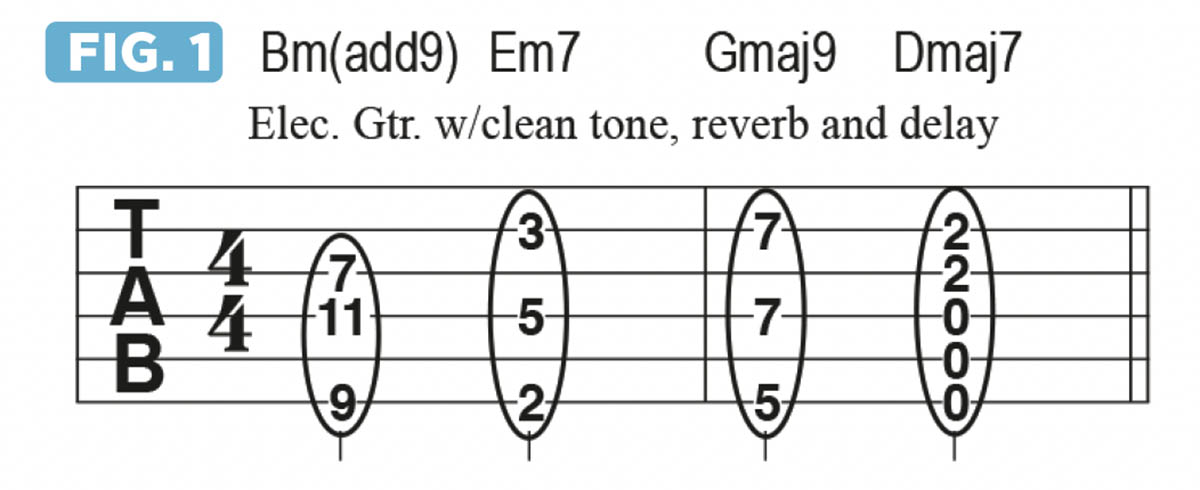Periphery’s Jake Bowen shows you how to layer multiple guitar parts to create a lush soundscape
In his inaugural instructional column, Bowen explains how a clean tone, some sweet chord shapes, reverb and delay can conspire to create something huge and magical

Hello, and welcome to my new Guitar World instructional column! In this series of articles, I’d like to share some of my ear-guided approaches to creating music, which the magazine’s editors have kindly helped me put to paper.
For this first lesson, I’d like to present an example of a compositional approach that I use in both Periphery and my solo projects: layering arpeggios to create broad, lush-sounding musical soundscapes.
The music I composed for this first column was written specifically for this lesson and comprises four different clean-tone electric guitar parts that are joined by two supporting instruments, all of which you’ll hear in the accompanying video.
I will break down this piece of music layer by layer to demonstrate how small, concise musical ideas can be combined to create a big, full sound. The tuning I’m using here is “drop-C,” or drop-D, down one whole step (low to high: C, G, C, F, A, D), so everything sounds a whole step lower than written.
The first musical layer, or Gtr. 1 part, functions as the foundation of the piece and is made up of the four chords illustrated in Figure 1: Bm(add9), Em7, Gmaj9 and Dmaj7. For most of these chords, I’m using a “spread” voicing, with wide intervals and notes played on non-adjacent strings. These chord shapes are often called “shell voicings” because they are sparsely structured and include only the essential “color” tones.

All of the layered guitar parts here are treated with delay and reverb. The delay is set to a dotted quarter-note rhythm, relative to the tempo of the piece, which is 120 BPM (beats per minute). The reverb is a long-tail hall reverb effect, with the “wetness” level set to 50 percent.

Figure 2 illustrates how the Gtr. 1 part is played: each chord in the progression is arpeggiated and held for two bars, as the notes are allowed to ring together. As I mentioned earlier, these chord voicings include some wide intervals – meaning a 5th or larger.
As I overdubbed additional guitar parts, I chose to voice their notes closer together and in a higher register, resulting in a seamless interweaving of guitars. I find that using smaller, tighter voicings on additional guitar parts serves to leave ample sonic room for each newly added part.

Figure 3 depicts the Gtr. 2 part. Over the foundational Bm(add9) chord, I play the notes E and F#, which are a whole step apart. Over Em7, I play B, D and F#, which are 3rds apart. Over Gmaj9, I play A, D and E, stacking a 2nd on top of a 4th. Over Dmaj7, I play F#, D and E, which is a 2nd on top of a 6th.

Figure 4 presents our next layer, the Gtr. 3 part, which is played in a syncopated rhythm that provides both added rhythmic and melodic-harmonic interest. The notes in this part are either 2nds or 3rds apart.
Notice how the overall harmony, with the added notes, has now become denser and richer, as reflected by the increasingly complex chord names.

Finally, the Gtr. 4 part, shown in Figure 5, simply doubles the Gtr. 3 part an octave higher. As a finishing touch, to these four guitar parts I added a piano and a celeste, which serve to reinforce the harmony while widening the timbral palette. These parts are treated with the same delay and reverb settings that I used for the guitars, so that everything “agrees” and meshes together well.
When all the parts are put together, the result is an expansive sound that’s filled with unusual and unexpected slap-back effects.
This is but one example of some of the creative “orchestral” approaches to composition that I’ll take to create broad soundscapes, via the use of contrapuntal guitar parts, various tones and effects and other, supporting instruments.
Get The Pick Newsletter
All the latest guitar news, interviews, lessons, reviews, deals and more, direct to your inbox!
“There are so many sounds to be discovered when you get away from using a pick”: Jared James Nichols shows you how to add “snap, crackle and pop” to your playing with banjo rolls and string snaps
Don't let chord inversions bamboozle you. It's simply the case of shuffling the notes around







![Joe Bonamassa [left] wears a deep blue suit and polka-dotted shirt and plays his green refin Strat; the late Irish blues legend Rory Gallagher [right] screams and inflicts some punishment on his heavily worn number one Stratocaster.](https://cdn.mos.cms.futurecdn.net/cw28h7UBcTVfTLs7p7eiLe.jpg)


